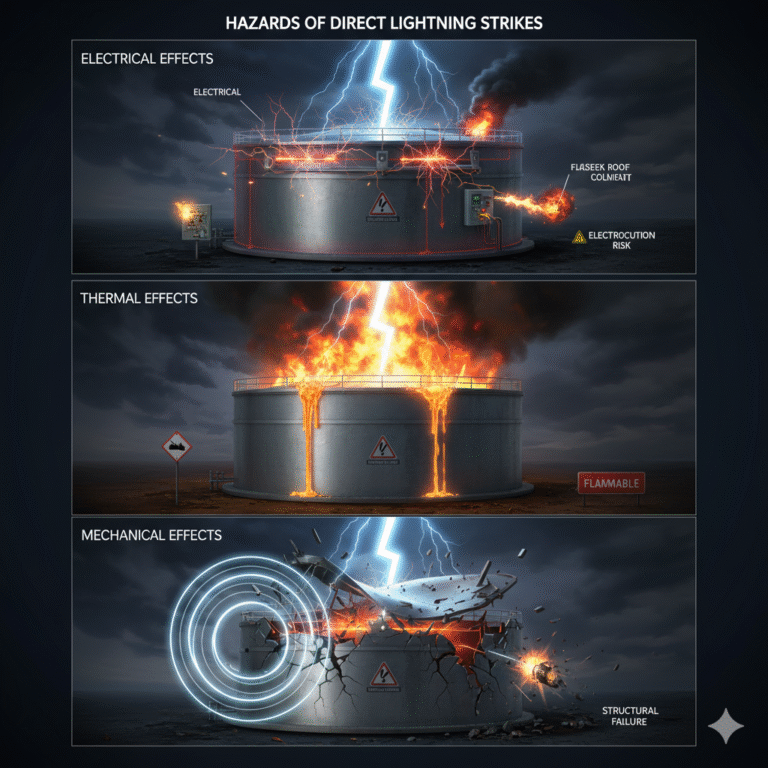The Three Major Hazards of Direct Lightning Strikes
Direct lightning strikes can cause three primary types of damage: electrical effects, thermal effects, and mechanical effects.
Electrical Effects
The electrical impact of a lightning strike is reflected in the high-voltage surge, which can range from several hundred thousand to millions of volts. When lightning strikes equipment, it generates significant force and heat. This overvoltage can break through insulation and damage grounding systems. The damage to insulation can also lead to high-voltage leakage into low-voltage circuits, posing significant risks of electric shock and fire or explosion accidents.
For example, when lightning flows through metal conductors of a storage tank, it may cause electrical discharges between the tank’s mechanical seals and the tank wall, producing sparks. Even a minor rusted connection between flange bolts can result in sparks at low lightning current (around 10.7 kA). If flammable materials such as vaporized oil or gas from the tank’s breathing valve are present, this can lead to fires.
Electrical effects can also damage weak electrical equipment installed on the tank, such as instruments. Poor equipotential bonding can result in sparking between the floating roof and the tank wall, leading to explosions.Thermal Effects
Thermal damage occurs when the intense lightning current flows through conductors, rapidly converting electrical energy into heat. This high temperature can ignite flammable materials, melt metals, or cause explosions. If lightning strikes flammable substances directly, it can cause large-scale fires.
For tanks with lightning rods installed on top, the lightning strike can create discharge risks at weak points (such as poorly welded connections or gaps in the floating roof seals), potentially causing sparks and leading to tank leakage and fires.Mechanical Effects
The mechanical impact from a lightning strike can physically damage the struck object, sometimes even causing it to shatter into fragments. This is due to the rapid expansion of gases and the sudden vaporization of moisture, which results in explosive forces. Additionally, electromagnetic forces between charges and air pressure waves produced by the lightning strike contribute to further damage.
The mechanical effects can cause local damage to weak points in the tank structure, such as melting or deformation at poorly welded areas. When flammable gas escapes through the breathing valve due to pressure build-up, the subsequent lightning strike can cause an explosion.

How to Prevent Lightning Strikes on Storage Tanks
Enhance Lightning Monitoring and Early Warning Systems
Strengthening weather forecasting and lightning alert systems can help mitigate the risk of lightning strikes. Wireless communication, big data, cloud computing, and mobile technologies can be used to create lightning warning systems that predict approaching lightning storms and track the movement of thunderclouds.Improve Tank Seal Design and Enhance Gas Detection
By adopting soft sealing materials instead of mechanical seals, tanks can reduce the risk of sparks and discharge. Additionally, using gas detection systems inside tanks can ensure safe operation and prevent potential hazards from combustible gases.Install Nitrogen Sealing Systems
Adding nitrogen gas sealing systems at the top of storage tanks can help reduce the risk of lightning. This system replaces air inside the tank with nitrogen, lowering the maximum explosion energy and reducing the likelihood of fire caused by lightning strikes.Install Proper Lightning Protection Systems
Lightning rods should be installed separately from the tanks, not directly on the tank itself, to prevent direct strikes. The lightning should be safely directed underground, preventing it from striking the tank and causing fires. Installation should follow the standards set out in the “Building Lightning Protection Design Code” (GB 50057-2010), which ensures proper protection around chemical plants, tanks, and pipelines.Utilize Plasma Lightning Protection Systems
Plasma lightning protection systems generate plasma to neutralize the electrical charge between lightning and its target, preventing direct lightning strikes. Studies show that this system can reduce lightning strike probabilities by over 80%, significantly improving protection for tank areas.Assess and Mitigate Lightning Risks
Regularly check for possible sources of lightning strikes and reinforce protective measures such as grounding, equipotential bonding between external equipment and tanks, and proper connections between floating roofs and tank walls. These measures help minimize the impact of lightning hazards.
